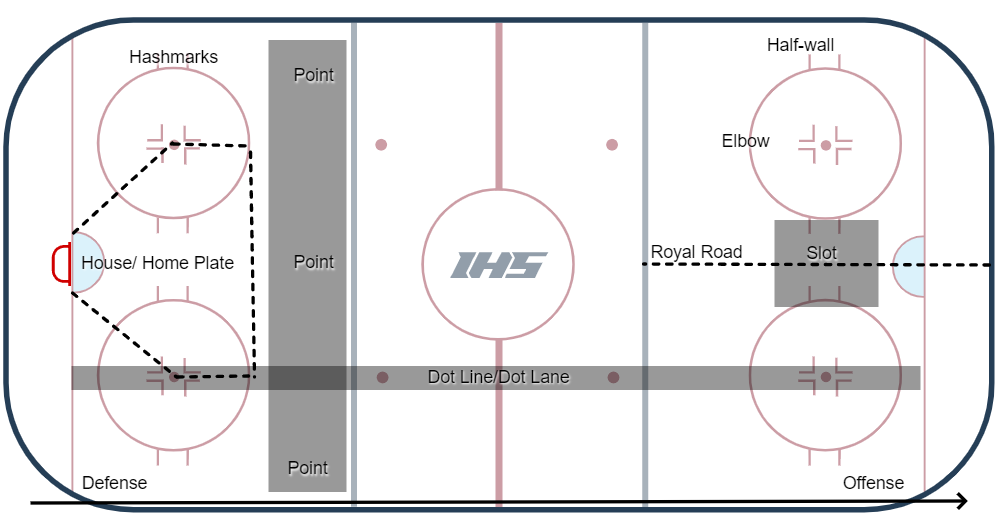At all levels of the sport, every team wants to break out and exit the defensive zone as quickly and cleanly as possible. But while much of the focus rightly keys on the retrieving defensemen, perhaps the most important player is actually the center.
Why? The center patrols the middle ice. By positioning alone, this means a center’s role is as a connector who can facilitate play.
Centers fulfilling their role well require four foundational pieces:
Awareness
Communication
Positioning
Timing & Speed
Awareness / Scanning
As with everything else in hockey, awareness is a key first step. Centers must look for where their teammates are and simultaneously identify where the pressure is coming from.
Once this information is gathered, centers can effectively act to help their team break out.
Related: Scanning for information.
While this section has the fewest words, it is simply the most important element.
Talk / Communication
Communication is critical to initiating great breakouts. Defensemen and wingers can be under a lot of pressure when trying to breakout - communicating as to who is open helps relieve that pressure
Here are some examples of how centers can help answer some critical questions:
How much time and space?
Yelling “time!” if they have time or “one!” if they have forecheck pressure. As an aside, your team should probably be fluent in a number of one-syllable words (rim, chip, wheel, wall, etc.).
Where is pressure coming from?
Centers can either tell where pressure is coming from
Yelling “Pressure wall” or “middle pressure” or “On you”
Or centers can tell their teammates where to go with the puck
Yelling “Go wall” or “Go middle” or “Skate”/“Wheel”
Positioning / Spacing / Routes
Good defensive positioning leads to a clean breakout and starts the rush up ice on a positive footing. Centers should be in the… center! A center’s job is to patrol the middle of the ice in the house/home plate.
Stops/Starts
To ensure the center is in quality positioning, they must stop and start rather than curling/turning. All of the best defensive centers are committed to stopping and starting in the defensive zone.
Staying Inside
A common mistake is when centers get too far outside and overrun the dot line. Centers can understand and use the dot markings on the ice as reference points for their spacing. Notice within this clip where the center (Auston Matthews, Blue #34) skates into his teammate’s space and gets stuck. The opposing defender is thus able to cover both players at the same time.

Compare that to this clip where Matthews does a great job staying inside the dot line to give quality spacing on the breakout. Now the opposing defender can only cover the winger and the center has space to make a play.
Timing (Low & Slow)
The hardest thing to teach centers on the breakout is the timing. Timing has three key elements:
Right place - Location, location, location. Becoming available in a support position with an open passing lane.
Right time - Becoming available when the pass can be made. Elongating the passing window and giving your teammate a support valve is key.
Right speed - Creating speed advantages, especially for availability and being able to create an advantage once the puck has been received. It’s better to be late than arrive early. Arriving slightly late gives players the ability to pick up speed. Arriving early creates a multitude of issues that domino.
When it comes to timing, it’s better to be a little late than a little early. It’s much easier to pick up speed than having to slow down first and then speed back up.
Routes
As we learned in Puck Acquisition, there are some great strategies to allow for well-timed routes. One example is “taking back ice.” A player takes back ice away from where they want to eventually go before accelerating towards the play once the timing is ready.
Another detail is staying “low”, as in low in the defensive zone. It’ll ensure shorter passing distances (higher chances of successful pass) and cleaner passing lanes. A great rule of thumb is to stay below the strong side winger’s positioning.
If a center gets too far ahead of the play they create a bad angle for a pass and put themselves in a bad position to receive a pass. By staying low and below the puck, they give their teammates better options.
As you can see from the video above, there are multiple times within the route where the center could receive the puck.
Controlled speed
Better to be a little late than a little early as it’s easier to speed up and out. It is very tough to slow down and then speed up.
Notice here how Matthews uses shuffles to control his speed.
It is critical that the centers have a good sense of timing so they can support the defense and wingers when they have the puck.
Defensemen and wingers rightly get plenty of attention when coaches work on breakout systems with their teams, but implementing these principles with centers will vastly improve your breakout quality.
Further Reading





